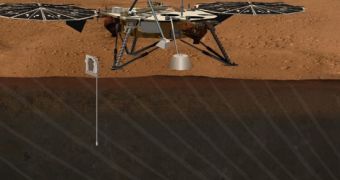Officials from the American space agency announce that they have selected the Geophysical Monitoring Station (GEMS) for Mars mission proposal as one of the final contenders for the next member of the Discovery Program.
NASA is currently assessing available proposals, deciding on which are the most suitable for further development with agency funding. GEMS has been included in the final round of decision-making.
The main mission the exploration robot will have on Mars will be to explorer the interior of the planet directly, through a series of direct measurements that will reveal more about how out neighbor formed.
Using these data, experts could also get a more accurate and thorough insight into the tectonic and geological processes that shaped Mars into the object we see today. According to plans drawn for the Discovery Program, the next mission would launch as soon as 2016.
This is the same year that the New Frontiers Program launches its newest vehicle, the OSIRIS-REx sample-return mission to near-Earth asteroid 1999 RQ36. The flight was selected a couple of days ago from a total of three final submissions.
Now, its time for Discovery Program officials to make their choice. GEMS is mostly American, but also features the heavy participation of experts from the German Aerospace Center (DLR).
The primary instrument on the lander will be the Heat Flow and Physical Properties Package, also known as HP Cube or HP3. It will contain temperature sensors, and be outfitted with drill bits capable of digging in up to 5 meters (16 feet) below the Martian surface.
“HP3 will give us new insights into the thermal development of Mars, and to water reserves that could be concealed beneath its surface,” explains the head of the DLR Institute of Planetary Research in Berlin-Adlershof, and the HP3 science leader, Tilman Spohn.
“This experiment has been carefully planned, and its outcomes could drive Mars research significantly forward. DLR is proud at the fact that its HP3 experiment is one of the successful mission proposals and could be a part of the next NASA Discovery mission,” the official adds.
“The involvement in the GEMS mission proposal falls within DLR’s strategy of building on international collaboration in the exploration of space,” he goes on to say. The German group was also involved in the 1997 NASA Mars Pathfinder mission.
The MESSENGER spacecraft currently orbiting Mercury, and the Vesta/Ceres-bound NASA Dawn spacecraft both feature cameras, spectrometers and image processing know-how from the DLR.
“The precise and direct measurement of heat flow under the surface will enable us to determine the heat produced deep inside Mars,” says DLR Institute of Planetary Research physicist Matthias Grott.
“This will give us insights into the composition of the Red Planet and its ongoing cooling process, which is related to the present volcanic activity,” he argues.
“In addition, HP3 will study the geological stratification of the first five meters below the surface of Mars – especially the presence of ice – through measurement of the geoelectrical properties of the ground,” Grott concludes.
The GEMS collaboration will now receive $3 million in NASA funding to develop the project even further. NASA will make a final selection of the next Discovery Program mission in 2012, Space Fellowship reports.

 14 DAY TRIAL //
14 DAY TRIAL //